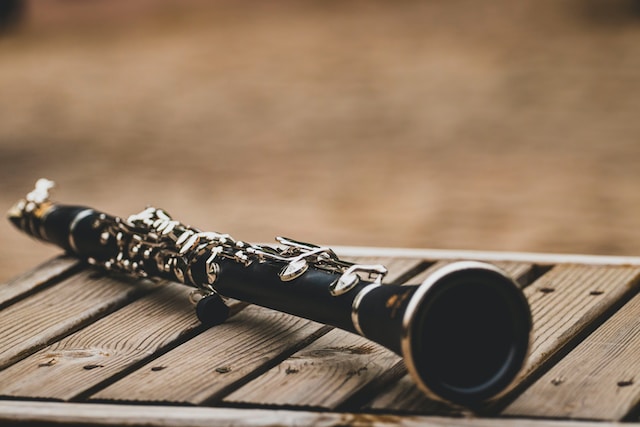How To Clean A Clarinet Reed?
It is absolutely necessary to clean your clarinet reed on a regular basis in order to preserve its quality, durability, and tone. The sound produced by the clarinet as well as its ease of playability are both directly influenced by the reed, which is an essential part of the instrument. In order to maintain the reed in its best possible condition, it is important to clean it on a regular basis so that collected moisture, germs, and debris may be removed.
In this tutorial, we will walk you through the process of efficiently cleaning the clarinet reed you use by providing you with detailed step-by-step instructions. The procedure of cleaning the reed, regardless of whether you use a cane reed or a synthetic reed, is rather straightforward and can be integrated into your routine of doing normal maintenance.
What is a reed?
When you examine a clarinet, you will see that there is a little piece of wood that is very thin and rests on the mouthpiece in a flat position. That is what we refer to as a reed. Cane reed is another name for the grass that is used to make the reed, which comes from the Mediterranean and is named Arundo Donax. It has a similar appearance to bamboo. After the Arundo Donax has reached its maximum size and been dried in the sun, it is then sliced into pieces that are both flat and rectangular in shape. Following the conclusion of that procedure, it will then be smoothed out and polished. After that, the reed is separated into its respective strength categories, labeled, packed, and finally sold.

When the clarinetist blows a steady airstream that is maintained by the instrument, a sound is produced on the clarinet. Reed vibrates back and forth due to the interaction of airflow and the elasticity of the reed, which results in the production of acoustic waves.
Step-By-Step Cleaning – How To Clean A Clarinet Reed?
1. Buy high-quality reeds to start with:
Make an investment in well-known brands such as Vandoren, which often have longer lifespans and superior overall performance. There are various brands available in addition to Vandorens for clarinet players to choose from; nonetheless, players of all ability levels have found success with Vandorens. If the cost ends up being an issue, you should be aware of where to locate discounts. However, a box of ten Vandorens can cost you four or five dollars each reed when purchased from your neighborhood music shop. Look for discounts and bargains online to find them at a price that is more reasonable for you.
2. Gradually break in new reeds:
The back of a teaspoon should be used to rub young reeds from the heart to the tip in order to assist seal the fibers gradually, which will increase their lifespan.
3. Soak reeds in clean water before playing:
Use sterile water to soak the reed in place of your saliva when you are going to moisten it.
4. Rinse and dry the reed after playing:
After rinsing the reed in clean water, dry it by patting it down with a cotton cloth or handkerchief, working your way toward the end of the reed. It’s also possible to accomplish it by passing it between your thumb and index finger when you’re in a hurry.
5. Rotate your reeds:
Instead of playing on just one reed for a significant amount of time and then beginning again with a new one, have three or four decent ones with you at all times and switch between them whenever you play.
6. Store reeds responsibly:
-
It is best to dry the reeds in a well-ventilated case with ribs on the floor to make sure air can get to every part of the reeds.
-
To prevent the tip of the reeds from getting damaged by waves, some reed cases have glass floors at the bottom.
-
A reed’s lifespan is always influenced by the amount of humidity it is exposed to. Depending on the case, there may be a replaceable cartridge that contains a substance that sits inside the case in order to regulate the humidity level there.
-
It is advisable not to store reeds in those little plastic cases that they come in when you buy them in the store. Despite the fact that there is nothing wrong with individually stored reeds, it is easier to lose them or mix them up, and after a while, they’ll start to pile up as well.
-
There is no need to keep reeds inside a closed case at any time. Mold will grow on them as soon as they are exposed to air.
7. Soak reeds in a hydrogen peroxide solution:
To counteract the effects of saliva, it is recommended that you soak reeds periodically in 3% hydrogen peroxide solution. After soaking them in the solution overnight, rinse them off thoroughly and use them again after rinsing them off.
8. Handle reeds with care:
In order to avoid damage to the clarinet, it is important not to leave it standing on its bell with the reed attached. To keep your reed moist while taking a break from playing, you should use a mouthpiece cap when taking a break from playing. Reeds should not be “wall tested” unnecessarily, as this can cause reeds to be damaged in the long run.
Reed Strength
There are different strengths of reeds available on the market. It is the thickness of the tip and the vamp of the reed that determines the strength of the reed. It is also possible to think about reed strength in terms of reed resistance in addition to reed strength. Because the response is quick when the reed tip is thinner, it will have a lower strength than a reed tip that is thicker. There is more resistance against the air stream that occurs when the reed tip is thicker, thus making a thicker reed tip more powerful. There are two different systems that are used by companies to label the strength of the reeds. There are a number of categories in which you can search: very soft, soft, soft-medium, medium, medium-harvested, and hard. There is also a system based on numbers that can be used in the second case. It will start with a very soft number 1, which will indicate the strength of the reed, and increase by increments of 0.5. On the front of the reed box, the strength of the reed will be clearly visible to the customer, so that they can make an informed decision.

It is very important for a clarinetist to choose a reed strength that is appropriate for their skill level. In order for the clarinetist to play to their full potential, it is essential that the strength of the reed does not interfere with that ability. Too soft of a reed will make the sound of the instrument excessively bright. It is also likely that there will be a lack of focus in the tone center. Too hard of a reed will result in muffled sound and an airy sound. Some notes may not be able to take part in the conversation in some cases.
Those who are just beginning to play clarinet should start off with a reed of “soft”/2.5 strength. Those who are playing clarinets with reeds that are too hard will experience a lot of resistance against the player, resulting in a frustrated musician. A clarinetist can experiment with harder reed strengths once they have developed strong air support and embouchure muscles through regular practice.
There is no doubt that the strength of a clarinet reed is an important factor to consider when considering the quality of a musician!
New Reeds
A good system for caring for and maintaining reeds is very important, because they are very delicate and fragile items.
The anticipation of receiving a brand new box of reeds is very exciting, as you can’t wait to play on them when you receive them. The reed must, however, be slowly broken in before playing on it for a full practice session before you start to use it for real. As soon as you open the box of reeds, the first day is the day to test them out. Make sure you test a minimum of three different reeds. Five minutes are the maximum time you should spend playing on a reed. Test the reed by observing how easy it vibrates, how responsive it is, how much resistance it offers, and how good the tone is while testing the reed. Playing for longer periods of time every day is a good idea. Due to the reeds reacting to the process of wetting and drying, the ranking of the reeds may change in the first couple of days after the reeds have been wetted/dried. Try experimenting with the positioning of the reed on the mouthpiece if the reed isn’t cooperating with you. Move the reed slightly higher up on the mouthpiece if there is a problem with the reed being too soft. When you feel that the reed on your mouthpiece is too hard, try lowering it a little bit. It may also be helpful to experiment with moving the reed to the left or right as well, since reeds are never perfectly balanced.
There is a gradual degradation of the cane over time as the reeds are being used. The recommended way to break in reeds is to choose reeds that are slightly harder than what you feel comfortable with. You will be able to get longer life out of these reeds.
Reed Placement
It is also vital to experiment with several positions on the mouthpiece in order to find one that permits the reed to perform up to its maximum capacity. It is important that the point of the reed and the point of the mouthpiece be parallel to one another. Above the tip of the reed, there should be only a sliver of the mouthpiece visible. However, the positioning of each reed on the mouthpiece will be somewhat different from one another. It is possible that every reed will require a few minute changes to be performed.
Reed Care
Before using the reed to perform an instrument, it has to be wet. Reeds are often wetted with saliva since this method is the most popular. However, it is usual practice for clarinetists to carry a small container containing water for their reeds in their case at all times. If you want to use the water bottle as your method of choice, you must remember to replace the water in it before each time you play.
Reeds that are newly purchased will arrive in a plastic container that allows for easy insertion and removal of the reed. It is highly recommended that you invest in a clarinet reed case that has been purpose-built for the storage and protection of reeds. When shopping for a reed case, these are some of the most important characteristics to look for: A level, solid surface for the reeds to lay on in order to prevent warping, three or more slots in which to store the reeds, and either a humidity controller or a location in which to store a humidity pack are all required components.
It is my recommendation that players always have at least three functional reeds stored in their reed case. It is fairly simple to zero in on your preferred reed and use that reed exclusively throughout the whole practice process. On the other hand, make it a routine to switch between at least three different reeds. The reaction of the reed can be affected by a variety of circumstances, including the climate, the relative humidity, the length of time the reed has been used, and the acoustics of the structure. Because of such variables, there is a chance that your go-to reed will stop functioning properly at some point. This is the reason why it is essential to have a minimum of three reeds in your reed case that have been damaged in some way. Read my post for more information on the other essential clarinet accessories.
Common Reed Problems
The following is a list of frequent reed difficulties that every clarinetist may experience at some point in their career, as well as potential remedies to these reed problems. These issues with the reeds are also significantly impacted by embouchure and air assistance.
No sound
The reed is either too difficult to play because it is too thick or because it is improperly positioned on the mouthpiece because it is fractured or chipped.
A fuzzy, breathy sound
It might be that the reed is too stiff, that it is not positioned properly on the mouthpiece, or that the reed is fractured or chipped.
Thin Sound
Either the reed is not firm enough or it is not properly positioned on the mouthpiece of the instrument.
Squeaks
It is possible that the reed is improperly put on the mouthpiece, that it is either too soft or too firm, that it has chips or breaks, or that it is damaged.







